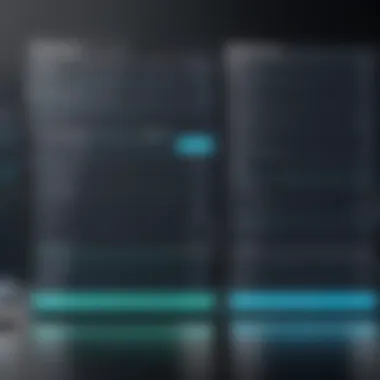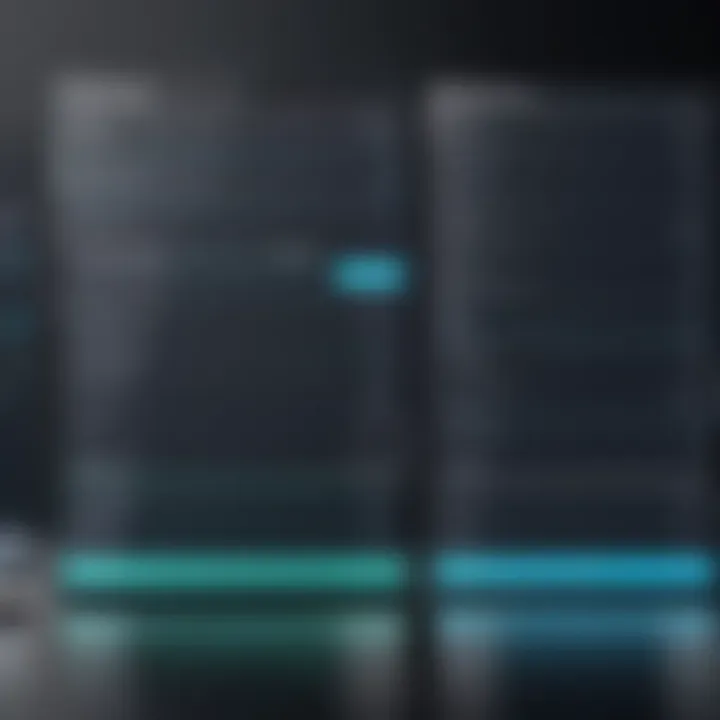In-Depth Analysis of Jonas POS Software for Businesses


Intro
In the ever-changing landscape of business operations, selecting the right point-of-sale (POS) software is crucial for success. Jonas POS software stands out as a formidable contender among various offerings available today. This guide journeys through the essentials of Jonas POS, shedding light on its functionalities, advantages, and potential drawbacks. Such insights are not just beneficial; they’re indispensable for professionals who want to make informed decisions on technology investments.
As businesses increasingly rely on digital solutions, the pressure mounts to choose a software system that not only meets their current needs but also scales with future growth. This examination provides a structured overview that does precisely that—from foundational features to intricate comparisons with competitors, it aims to empower decision-makers with knowledge to streamline their operations effectively.
Prelims to Jonas POS Software
In today’s fast-paced commercial landscape, having a reliable point-of-sale (POS) system is not just a luxury—it's a necessity. The core function of a POS system is to facilitate transactions between businesses and customers. However, the significance often extends far beyond that, encompassing aspects like inventory management, sales tracking, and customer relationship management. In the context of this article, highlighting the importance of Jonas POS Software serves as a foundation to explore its unique features, benefits, and nuances that can impact business operations.
Investing in the right POS system can drastically enhance efficiency, improve customer interactions, and provide valuable insights into sales data. When we talk about Jonas POS Software, it comes packed with functionalities that cater explicitly to the nuances of diverse business models. So, understanding what this software offers can be the difference between just getting by and truly thriving in a competitive market.
Overview of POS Systems
To grasp the significance of Jonas POS Software, one must first understand what POS systems are. At its core, a POS system acts as the juncture of sales, where the retail transaction happens—it's the digital cash register, if you will. But today’s POS systems have evolved dramatically. They now include hardware and software that manage not only payment processing but also inventory control, customer relationship management, and even employee management.
For example, many systems today integrate with major accounting software, allowing seamless data flow and minimizing manual entry errors. The best POS systems today operate in real-time, providing businesses with immediate insights into their sales and inventory status. Having this capability can feel like having a crystal ball in business, ultimately leading to better decision-making.
Significance of Choosing the Right POS Software
Selecting a point-of-sale software is akin to choosing a trusty compass for a long journey. It guides operational efficiency and has a direct impact on customer satisfaction. Businesses must consider specific functional needs before making such a choice. Will the software integrate well with existing systems? What about customer support?
- Compatibility is critical. Not all POS systems can work well with every type of hardware or software. It’s essential to evaluate how well Jonas POS integrates with existing technologies.
- Ease of Use should not be underestimated. A complex interface can lead to training challenges for staff members, which can ultimately reflect negatively on service.
- Scalability is another aspect that is imperative in the decision-making process. As businesses grow, their needs evolve, and the POS system must grow with them.
Choosing the right POS software isn't just about selecting one tool; it's about ensuring that it aligns with the company’s goals and operational needs. In this analysis, Jonas POS Software stands out for its range of functionalities, which play a pivotal role in modern retail settings.
"An investment in a strong POS system is, in essence, an investment in customer satisfaction, operational efficiency, and business intelligence."
By diving into the details of Jonas POS Software, professionals can discover how aligning the right technology with their business processes can lead to more informed decision-making and a boost in overall performance.
Key Features of Jonas POS Software
Understanding the key features of Jonas POS software is crucial for any business evaluating potential point-of-sale solutions. These features can greatly influence the effectiveness and efficiency of operations across various sectors, from retail to hospitality. The right POS system should not only facilitate transactions but also enhance overall business management. So, what makes Jonas POS stand out among the competitors? Let’s break it down to see the unique attributes that might sway decision-makers in its favor.
User Interface and Experience
A smooth user interface can be the difference between a dream and a nightmare at the checkout. Jonas POS prioritizes intuitive design, ensuring that users, regardless of their tech-savviness, can navigate through it without pulling their hair out. The dashboard is clean and organized, bundling essential functions in an easily accessible manner. Users can swiftly process sales, manage returns, and look up product information, all without stumbling down a maze of menus.
For example, imagine a busy restaurant during lunch hour. A server using Jonas POS can ring up an order with just a few taps, saving precious seconds that could mean the difference between happy diners and long wait times. This type of efficiency is not merely a luxury; it’s a necessity in fast-paced business environments.
Inventory Management
Effective inventory management is like being in the driver's seat of your business. Jonas POS simplifies tracking stock levels, allowing businesses to know exactly what products are flying off the shelves and what items are gathering dust.
- Real-time Tracking: With the built-in tools for monitoring inventory, businesses never have to worry about stockouts or overstock situations again. Managers can set reorder thresholds that trigger alerts, keeping operations seamless.
- Stock Adjustments: Need to adjust stock levels due to returns or breakage? The quick adjustment feature allows quick corrections, keeping inventory accurate.
- Supplier Management: Jonas POS also helps in maintaining supplier relationships with functions for tracking orders and setting up preferred vendors. This adds layers of organization that many business owners appreciate.
Sales Reporting and Analytics
In the age of data, having robust reporting tools integrated within your POS system is indispensable. Jonas POS excels in this area by offering analytical tools that provide insights into sales trends, customer preferences, and overall business performance.
- Customizable Reports: Users can generate tailored reports focusing on specific time frames, product categories, or even employee performance. This level of customization allows businesses to dig into the minutiae of their operations without feeling overwhelmed.
- Visual Dashboards: Instead of sifting through endless spreadsheets, the software displays data visually, making it easier to grasp complex information and trends at a glance.
- Actionable Insights: Forget just collecting data; Jonas POS transforms numbers into action plans. Businesses can quickly identify what’s working and what’s not, allowing for timely strategic decisions.
"In the world of sales, knowledge is power. Jonas POS puts that power directly in your hands."
Benefits of Using Jonas POS Software
In today's fast-paced business environment, an effective point-of-sale (POS) system can make or break an operation. The benefits of using Jonas POS Software run deep, often reflecting not just on individual transactions, but also on the broader business framework. This analysis will delve into key advantages that make this particular software a worthwhile investment for businesses across various sectors.
Enhanced Efficiency in Transactions
One of the most vital benefits of Jonas POS Software lies in its ability to streamline transactions. In the bustling atmosphere of a retail store or a busy restaurant, speed and accuracy are paramount. With features like quick checkout processes and real-time inventory updates, the software reduces wait times, enabling staff to serve customers faster.


- Quick processing: By optimizing the checkout experience, employees can focus on customer service rather than fumbling with registers.
- Error reduction: Built-in checks minimize human error during transactions, thus safeguarding revenue.
- Integration with payment platforms: The seamless connection with various payment options means customers can transact however they prefer without delaying the process.
This efficiency can significantly affect customer satisfaction. Smoother transactions keep patrons happy, leading to better reviews and repeat business.
Improved Customer Relationship Management
In business, understanding your customer is crucial for growth. Jonas POS Software provides valuable data to enhance customer relationship management (CRM). By tracking purchasing patterns, businesses can tailor marketing initiatives and promotions to meet client needs effectively.
- Customer profiles: The software allows businesses to maintain detailed profiles of their customers. This information enables personalized service, which can foster loyalty.
- Targeted promotions: Knowing a customer's preferences can guide marketing efforts. Say you see a customer consistently purchasing specific items; you could offer them exclusive deals on those products.
- Feedback integration: Incorporating customer feedback into business operations is another way this software excels. From surveys to comment sections, gathering insights helps refine services.
By focusing on customer relationships, businesses can cultivate a loyal customer base that drives long-term success.
Customizability and Scalability
Every business is different, and having a one-size-fits-all solution rarely works. Jonas POS Software addresses this need through its customizability and scalability. Companies can adapt the system to their unique requirements, ensuring optimal performance as they grow.
- Tailored features: Businesses can select features specific to their operations—be it retail, food service, or something else entirely—creating a bespoke solution to fit needs.
- Scalability: As a business expands, it can easily add more functionalities without heavy investment. This limits the need for completely overhauling the system down the road, thus saving both time and money.
- User-friendly adjustments: Modifying settings or adding new products is straightforward, making it easier for employees to adapt to changes without extensive retraining.
In the end, the ability to customize and grow with the business ensures that the software remains relevant and helpful, making it a top choice for many organizations.
"Efficiency is doing things right; effectiveness is doing the right things." - Peter Drucker
By leveraging these benefits, businesses can harness the power of technology to optimize their operations, improve customer satisfaction, and lay a foundation for sustainable growth. Jonas POS Software stands out not just as a tool for transactions, but as a partner in business evolution.
Limitations of Jonas POS Software
When considering Jonas POS software for a business, understanding the limitations is paramount. No software is perfect, and recognizing its shortcomings allows organizations to make informed decisions. Each limitation can have implications for the overall effectiveness of the system, thus affecting daily operations and customer satisfaction.
Potential Learning Curve
One of the more noticeable challenges users face with Jonas POS software is its potential learning curve. While it's designed for a broad audience, those who aren't tech-savvy might find some aspects a bit intimidating at first.
For instance, navigating through its vast features—be it inventory management or analysis reports—may take additional time to master. New users might need to invest time in training sessions or tutorials to get a full grasp. This can disrupt usual workflows and create temporary slowdowns in efficiency.
"Investing in initial training could be the difference between a smooth transition or lengthy frustrations."
Integration Challenges
The challenge of integrating Jonas POS with existing systems cannot be overlooked. Businesses often rely on a mix of software for various operations, from accounting to customer relationship management. When a new POS system is introduced, it ideally should play nice with these pre-existing solutions.
Unfortunately, users have reported hurdles with seamless integration. For instance, if a business is using specific accounting software, the process of data synchronization might not be as streamlined as expected. Incompatibility can create extra labor for IT staff, or worse, can lead to data inconsistences which can be googling. Strong communication with support teams becomes essential to address these integration concerns promptly.
Cost Considerations
Cost is another area of concern that users need to evaluate. While Jonas POS might offer robust features, the price point can be significant. Beyond the subscription fees, there are additional hidden costs that often come into play. These may include charges for additional features, customer support, or even scaling the software as the business grows.
Businesses, particularly smaller ones, might find these fees a bit startling. It's advisable to thoroughly sift through the pricing structure before committing, ensuring that each aspect aligns with the company’s budget and expectations.
Comparison with Competitors
When choosing a point-of-sale system, taking a closer look at how Jasper POS stacks up against its competitors is essential. The world of POS systems is crowded, with numerous options available. Each option comes with its unique features, pricing structures, and user experiences. Thus, a detailed comparison can provide critical insights that influence decision-making for businesses looking to enhance their operations.
In particular, understanding these comparative advantages or disadvantages helps businesses determine the software that best aligns with their goals and day-to-day needs. Here are three widely used competitors to consider:
Jonas POS vs. Square POS
Square POS is a well-known player that shines in its versatility. It's particularly favored by small businesses and those in the retail and food industries. The interface is user-friendly and intuitive, which makes it appealing for neophytes. One notable point is the ability of Square to provide free basic software, charging only for transaction fees, something that can be very alluring for startups working on a lean budget.
On the other hand, Jonas POS offers advanced features tailored for industries such as construction and service management, focusing deeply on specialized inventory and project tracking, which typical small retail businesses may not require. Furthermore, while Square price structure is laden with per-transaction fees, Jonas provides a fixed monthly subscription. This aspect may appeal to companies looking for predictability in their budgeting.
Jonas POS vs. Shopify POS
Shopify is another heavyweight, particularly known for its eCommerce capabilities alongside its POS offering. Many retail businesses appreciate the seamless integration between online and brick-and-mortar operations. For businesses heavily involved in eCommerce, Shopify POS offers a solution that neatly ties both online and offline sales strategies together.


However, if a business is primarily focused on services rather than products, Jonas POS holds an advantage. Its specialized features for service management, like job costing and advanced billing options, cater to industries whose operations might not fit neatly into the product-centric world that Shopify often caters to. Additionally, Jonas is known to frequently update its features based on industry-specific feedback. This adaptability can prove beneficial for businesses needing a more tailored approach to POS functions.
Jonas POS vs. Clover POS
Clover is often celebrated for its robust system that offers a variety of hardware options and extensive app integrations. Businesses that prioritize aesthetics and customization might find Clover appealing due to its diverse hardware choices and user-centric design.
However, the depth of features in Jonas POS targeted towards project and job management arguably surpass what Clover provides, especially for industries such as construction. Known for its resilience in handling billing complexities and project-based inventory, Jonas excels where Clover might fall short. Additionally, Clover's fees can quickly add up with added apps and services, making it vital for potential users to calculate the long-term costs associated with the system.
In summary, while Clover and Square cater to a broad audience with their straightforward offerings and lower entry costs, Jonas POS targets niche industries with its specialized features and subscription pricing model.
"Understanding the competition is not just about knowing how they stack up, but how they align with your specific needs. "
For businesses, it is crucial to weigh these comparisons well to make a calculated choice of POS systems that aligns with their operational demands and growth trajectories.
User Experiences and Testimonials
User experiences and testimonials play a pivotal role in assessing any software, including the Jonas POS. They offer a real-world snapshot of how this system integrates into daily business operations, spotlighting both its strengths and weaknesses. For potential users, feedback from current customers can bridge the gap between marketing promises and actual functionality. It’s about seeing how others have navigated the very waters you're contemplating diving into.
A detailed understanding of user experiences helps stakeholders gauge areas where the software excels or falls short. It serves a dual purpose, ensuring that decision-makers assess the software critically while also gleaning insights into practical applications that might not be covered in promotional materials. This analysis emphasizes why choosing software shouldn't be solely based on features but also on how those features resonate with day-to-day tasks and long-term goals.
Positive User Feedback
Many users have positively reflected on their experiences with Jonas POS software. What regularly emerges from user testimonials is an appreciation for its intuitive interface and robust customer support. For instance, a small restaurant owner noted that "the simplicity of the dashboard has made training new staff a breeze." This ease of use significantly reduces the time spent on onboarding, allowing businesses to focus on customer satisfaction right from start.
Additionally, users frequently highlight the inventory management features as a standout benefit. Many have expressed gratitude for the precision it brings to tracking stock levels. One retail manager commented, “I can’t imagine running my store without the live inventory updates. It’s like having an extra employee who never takes a break.”
Positive reviews also emphasize the responsiveness of the customer support team. Users often mention that any issues they encounter are swiftly resolved, ensuring minimal disruption to operations. Such testimonials can provide the reassurance needed for businesses hesitant about investing in software that claims to enhance efficiency.
Negative Reviews and Concerns
However, it’s not all smooth sailing. Some users have articulated concerns that merit consideration. For example, some reports have surfaced regarding integration issues with existing systems. A hotel manager expressed frustration, saying, "While the software is great, connecting it with our booking system took far longer than expected. It was quite a headache." This points to potential challenges that could arise when layering new systems on top of established ones.
Cost is another recurring theme in negative feedback. While many recognize the value provided, some still feel that the pricing structure isn’t entirely transparent. A common sentiment echoed among reviews is the feeling of unexpected costs popping up here and there, which can lead to budget concerns. Responding to these critiques, the providers have made efforts to clarify pricing tiers and additional fees, but the mixed messages in the past can leave lingering doubts about overall affordability.
Ultimately, engaging with both the positive and negative reviews provides a holistic view of the Jonas POS experience. Each user's perspective adds layers of depth that can guide another's decision-making process, ensuring that potential users aren’t left swimming in uncertainty but rather equipped with nuanced insights to make informed choices.
Implementation Process
The implementation process of any software is the bridge that connects initial planning with operational reality. In the case of Jonas POS Software, it is crucial for businesses to take a systematic approach to ensure that every feature and function is utilized to its full potential. The effectiveness of this software relies significantly on how well it is implemented. Proper implementation can reduce the likelihood of disruptions, enable quick adaptation, and enhance overall user satisfaction.
Initial Setup and Configuration
The first step in the implementation process is the initial setup and configuration of the software. This involves tailoring the POS system to fit the specific needs of a business. Every business has unique requirements; therefore, it is essential to not take a 'one-size-fits-all' approach.
During the initial setup, you'll want to focus on several key areas:
- User Accounts: Create user profiles for staff with appropriate access levels. This not only secures sensitive information but also simplifies the user experience.
- Hardware Configuration: Ensure that all hardware components, such as scanners, tablets, and printers, are correctly integrated. Any mismatches at this stage can lead to frustrations down the line.
- Inventory Setup: Inputting products and pricing information accurately is vital. This aids in streamlining the sales and stock management processes right from the get-go.
The efficiency of the initial setup ultimately lays the foundation for future usage. A well-configured system frees staff from mundane tasks, allowing them to focus on providing quality customer service instead.
Training and Onboarding
After the dust settles from the initial setup, the next focal point is training and onboarding. Implementing new software can be daunting, particularly for staff who may not be tech-savvy. Therefore, a well-structured training program is essential.
Here are some aspects to consider during the training phase:
- Hands-on Training: Real-world practice is invaluable. Employees should engage with the system under guidance to build confidence and familiarity.
- Documentation: Providing clear, concise user manuals or online resources helps staff reference procedures when needed. This can mitigate confusion and reduce the time spent on troubleshooting.
- Regular Quick-Start Sessions: Hosting periodic refreshers can reinforce the training and keep employees current.
Ultimately, investing time in training pays dividends. Employees who understand the software well can swiftly address customer needs, leading to a smoother operational flow and improved customer satisfaction.
Ongoing Support and Maintenance
Finally, no implementation would be complete without ongoing support and maintenance. The digital landscape is always changing, and so too are customer needs and software capabilities. Businesses must have a support system in place to handle issues as they arise and facilitate updates or improvements.


Key elements include:
- Technical Support: Having access to instantaneous help through chat, phone, or email is critical when problems crop up. Without effective support, minor glitches can evolve into major operational headaches.
- Regular Software Updates: Staying current with software versions is essential to utilize new features and security measures. Routine updates can address bugs and improve overall system performance.
- Feedback Mechanism: Encourage users to provide feedback regarding functionality and any hurdles they encounter. This data can be invaluable for identifying areas that require attention or enhancing user experience.
Efficient ongoing support ensures that the initial implementation efforts do not go to waste and keeps the software aligned with changing business needs.
Overall, the implementation process for Jonas POS Software is not just a one-time task; it's a continuing effort that demands focus on setup, training, and support. When these elements are meticulously attended to, businesses can leverage the full power of the software, ultimately driving better performance and customer satisfaction.
Pricing Structure
The pricing structure of any software is a cornerstone in any buying decision, especially with a product like Jonas POS software. Understanding how the pricing works is essential for businesses as it not only affects initial financial outlay but also ongoing operational costs. For companies seeking an effective point-of-sale solution, a transparent pricing structure ensures that there are no nasty surprises lurking in the fine print. This section unravels the subscription plans and additional fees associated with Jonas POS software, equipping decision-makers with the necessary knowledge for financial planning.
Subscription Plans Overview
Jonas POS software offers several subscription plans tailored to meet diverse business needs. The main plans include Basic, Professional, and Enterprise tiers. Each comes with a different set of features and capabilities designed to cater to varying scales of operations.
- Basic Plan: This is ideal for small businesses or startups. It includes essential features like sales tracking and basic inventory management. The monthly fee is specifically designed to keep costs low and manageable.
- Professional Plan: As businesses grow, so do their needs. The Professional Plan incorporates advanced reporting tools and customer management features. This tier's pricing reflects the added functionalities, providing better ROI for mid-sized operations.
- Enterprise Plan: Tailored for larger organizations or those with complex requirements, the Enterprise Plan offers extensive customization options. Although this comes at a higher price point, the value it brings often justifies the cost, especially when considering the available support and integrations.
While specific prices might fluctuate, it’s crucial to keep in mind that the level of service and customization typically correlates with the plan tier selected. Evaluating the right plan means not just looking at monthly fees but also considering how well the selected tier aligns with your business goals.
Additional Costs and Fees
While the subscription plans outline the basic expenditures, businesses must be alert to potential additional costs that may arise. These can significantly impact overall budgets if not recognized early on. Here are several common additional costs associated with Jonas POS software:
- Setup and Installation Fees: Depending on the complexity of your requirements, Jonas may charge a fee for initial setup and configuration, which could include integration with existing systems.
- Training Costs: Investing in training is vital for smooth onboarding. Although some plans may include basic training, companies might need to budget extra for extensive training sessions,
- Payment Processing Fees: If you are accepting card payments through the POS, be aware that transaction fees may be applicable. These are usually a percentage of each sale and can add up over time.
- Ongoing Support and Upgrades: Some subscriptions might require additional fees for premium support. Additionally, software upgrades or enhancements might incur costs depending on your plan.
In summary, while the base subscription offers a clear starting point for budgeting, potential additional fees must be carefully considered to avoid going over budget.
"Understanding the entire pricing landscape for Jonas POS software is as essential as choosing the right features. Plan ahead to ensure financial stability."
Through a thorough comprehension of the pricing structure, businesses can effectively strategize their budgets and investments in Jonas POS software, making informed decisions that align with their operational needs and financial capabilities.
Future Developments and Updates
As the retail and service environments evolve, the significance of staying current with technology is more pronounced than ever. Future developments and updates in Jonas POS Software not only enhance functionality but also ensure that the software remains relevant in an increasingly competitive landscape. Businesses must be cognizant of these upcoming changes as they can provide a significant edge, allowing companies to adapt swiftly to market demands and customer needs. This forward-thinking approach can directly impact a business's bottom line.
Anticipated New Features
One of the most exciting aspects of Jonas POS Software is its commitment to innovation. A few anticipated new features in the pipeline are:
- Mobile Compatibility: With the rise of mobile commerce, enhancing the mobile application can help businesses manage their operations and sales right from their handheld devices. This can streamline transactions and improve customer engagement on the go.
- Enhanced Analytics Tools: Greater integration of AI-driven analytics will likely become a feature. This means users can expect refined reporting tools that provide deeper insights into sales trends, customer behaviors, and inventory management.
- Integrated Marketing Solutions: In an era where leveraging data for effective marketing is crucial, options for email marketing and customer loyalty programs might be built into the platform.
- User Interface Improvements: As intuitive design becomes essential, updates aimed at simplifying user interfaces to promote ease of use will likely be introduced. This can significantly reduce training time and improve overall user experience.
Such features showcase a commitment to driving functionality while also considering user experience, making Jonas deal more appealing.
Market Trends Impacting Future Enhancements
Understanding the broader market trends can provide essential context for upcoming enhancements in the Jonas POS Software. A few notable trends include:
- Emphasis on Omnichannel Retailing: As consumers increasingly expect seamless experiences across digital and physical channels, Jonas is likely to enhance features that allow businesses to synchronize online and offline sales and inventory management.
- Growing Importance of Cybersecurity: With the uptick in data breaches, future updates may focus on strengthening security protocols, ensuring businesses can protect customer data effectively.
- Adoption of Contactless Payment Solutions: The demand for contactless transactions continues to rise. Anticipating this, updates may introduce new payment gateways or integrations that facilitate quicker transactions.
- Sustainability Practices: As businesses integrate sustainability into their operational strategies, POS software enhancements may include features that help track the carbon footprint or manage sustainable product lines.
The End and Recommendations
The conclusion of this analysis serves as a pivotal moment for readers, encapsulating the wealth of insights gathered throughout the article and providing direction for decision-making. Jonas POS software presents a tool that can significantly enhance operational efficiency, especially for those at the helm of small to medium-sized businesses. As companies strive to streamline their processes and improve customer engagement, understanding the nuances of this POS system becomes increasingly crucial.
A discerning choice in POS software often correlates directly with improved sales tracking, inventory oversight, and customer relationship management. Thus, concluding this deep dive allows readers to reflect on the various features and limitations discussed, pinging back to how these attributes align with their business needs and strategic goals.
Final Thoughts on Jonas POS Software
In the ever-evolving realm of retail and service industries, Jonas POS software stands as a robust option. It’s not just about selling; it’s about creating an ecosystem where transactions flow smoothly and data-driven decisions can be easily executed. Users have frequently pointed out its intuitive interface, which facilitates rapid operations and minimizes the likelihood of frustrating hiccups during peak hours.
Moreover, with its strong analytics capabilities, organizations can leverage insights from sales patterns, inventory turnover, and customer feedback. These aspects are essential in making informed choices that propel business growth.
However, it is important to acknowledge that like any software, Jonas has areas for enhancement; a bit of patience may be required for those unfamiliar with such systems.
Who Should Consider This Software
This software suits a diverse range of businesses. Specifically, establishments engaged in hospitality, retail, or any service-oriented function could gain substantial advantage from its implementation. Here are some signals that Jonas POS might be a good fit:
- Startups looking for scalability: As businesses grow, the need for a reliable POS that adapts is paramount.
- Inventory-heavy businesses: Companies that deal with multiple products and require stringent tracking methods will find its inventory management features particularly beneficial.
- Customer-centric operations: If your business thrives on customer engagement, the CRM integrations make Jonas POS a worthy consideration.
Remember, evaluating any POS system should involve critical analysis tailored to your current and future business requirements. The proper software can be a game-changer, making the complex simple and turning every transaction into a valuable data point.







